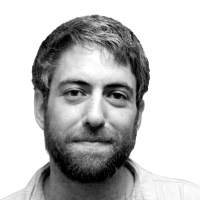SINJAR, Iraq — The rough road to the front is marked with shell craters, the streets in the ghost towns that line it are stained with blood. A mile and a quarter from the Syrian border, the shifting front lines in the war against the so-called Islamic State zigzag around the Iraqi side of Mount Sinjar, scene of the humanitarian crisis that helped draw the United States and an international coalition into this fight.
Last summer the fanatical zealots of ISIS, as the Islamic State is widely known, set about slaughtering Yazidis, whom they consider pagans. They murdered Yazidi men en masse. They carried away young boys for indoctrination. They enslaved and raped Yazidi women and girls. In some cases, Yazidis were saved from ISIS by their Sunni Arab friends, but in others, to the horror of the Yazidi families fleeing the onslaught, their Sunni Arab neighbors threw their support behind ISIS, not only collaborating but seizing the homes and belongings of people they had known all their lives.
In August, President Barack Obama vowed, “America is coming to help.” But here on the ground the results of this war are just about as grim as it is possible to imagine. The signs of atrocities committed against Yazidis are everywhere, yes, and so are signs of reprisal taken against Arab villagers after Kurdish forces have re-conquered territory lost last summer.
This rocky terrain is the scene of a merciless war that carved festering wounds into communities that once lived in peace and harmony.
Camps overflowing with Yazidi refugees are the first signs of the devastation inflicted in the mountainous region over the past several months.
“We saw families get caught by ISIS—they took our neighbors,” says Sozan Simo, a 49-year-old Yazidi woman now living in the Bajet Kandala camp 10 miles from the front. Coalition airstrikes can be heard in the distance, but she counts herself lucky to have escaped along with nine members of her family. In October, jihadists had tried to hunt them down just outside their village on Mount Sinjar. The jihadists were driving U.S.-made Humvees taken from the Iraqi army.
Less than a mile from the front lines around the town of Sinjar, clothes belonging to women and children have been ground into the dirt on the hillside road, dumped by families jettisoning their belongings in their frantic effort to get beyond the grip of the self-proclaimed caliphate. The burned and bombed-out civilian cars tell the stories of those who didn’t make it.
As for those captured, Simo’s husband, Khalid Kird, says he was a witness to the gruesome reality of what happens to Yazidis in clutches of the jihadists. During the 40 days the family spent hiding in the mountains, he says, he saw a terrible massacre.
“I saw them separate the younger men from the older ones, boys, and women,” says Kird, sitting outside a tent provided by the United Nations Refugee Agency. “They took the younger men, 200 to 250 of them, and executed them,” he continues in a voice oddly devoid of emotion. He saw the survivors put on trucks and, he understand from others who later escaped, the captives were taken to Mosul or Raqaa and sold.
In the mountain range around Sinjar city, U.N. tarps cluster together in makeshift informal refugee villages on the slopes and in the valleys. It’s about a mile and a half to the front where fighting still rages in the center of the of the city, and the sounds of machine-gun bursts and RPG attacks are constant, while plumes of smoke from coalition airstrikes regularly mushroom toward the sky from the urban landscape below.
This is an area where Yazidis braved the cold with little food and shelter from last October to December in the hopes they could evade the iron fist of Abu Bakr al Bagdhadi’s Islamic State.
“There were 1,250 people here that we were protecting,” says 65-year-old Yazidi volunteer fighter Elias Kassim. He stands next to another elderly combatant with a graying handlebar moustache. With his M16 leaning against the wall of the small tent, he watches the battle rage below while describing how they only had 50 volunteer fighters and light weapons to protect the families. “For months we were surrounded by ISIS,” he says. They survived on what they could capture in hit-and-run attacks on the jihadists and with supplies from U.S. airdrops.
Down in the city, Iraqi Kurdish Peshmerga units fight alongside guerrillas from Turkey’s left-wing Kurdish PKK and its sister organization, the Syrian Kurdish YPG, that fought to liberate the embattled town of Kobani, Now they are navigating the urban jungle trying to force ISIS from Sinjar.
Apart from Pesh pickup trucks rushing troops to sandbagged and reinforced high ground looking into the streets below, the area seems deserted. Then, several women from the YPG dart from a house in the rear towards their front line positions as the bullets from an enemy sniper whistle past.
“The fighting is so close that we are sometimes fighting with rocks,” says Peshmerga Col. Ramadan Said Moustafa. In close-quarters ambushes, when fighters seem to appear out of nowhere, soldiers grab slabs of stone or anything else that comes to hand to bash in their enemies' heads.
The grizzled, stout and stern commander has his radio tuned to ISIS’s frequency as we stand behind a wall of sandbags on a hill just above the streets. Static-filled fuzzy communications in Turkish and Arabic blare constantly. “Sometimes we hear English,” he says, alluding to the foreign fighters who have ravaged the communities around them.
A network of Pesh, YPG, and PKK checkpoints control the streets in the disturbingly quiet former Yazidi neighborhoods checkering the front lines. ISIS propaganda is spray-painted on the walls and the evidence of the slaughter here lies, literally, just below the ground.
The flat-land town of Khansor was home to 38,000 Yazidis before ISIS came. Now it’s empty and the black flags that have instilled terror still fly less than half a mile away, but diggers are hard at work unearthing mass graves of civilians stumbled upon by shepherds who return briefly to see if any of their flock is left.
Lt. Lokman Koli Ibrahim was a journalist from the town before he joined the Pesh to fight the persecution of his community. As we drive with him to the site of a mass grave where 37 civilians of all ages were beheaded on the edge of town, he says that 10,000 people from Khansor are still unaccounted for.
“There were children and elderly—70 to 75 years old—killed here,” he says as we walk around a pit that had been discovered the day before. Flipping through photos on his phone of the bodies being exhumed, he says they were probably executed not long after ISIS took the area in August. He bends down and lifts a severed skull still at the gravesite to show how these people were beheaded. Lt. Ibrahim knew some of the victims, although most were decomposed beyond recognition.
He tells a story of a man who found a key in the pocket of one of the corpses and thought it looked familiar. Only when he put it in the door of his own home and it worked did he know for sure that the body he had found was the body of his father.
The open pit of the mass grave still has bits of children’s clothing inside and even a pink stuffed animal. The ground has bloodstains dried around it. Lt. Ibrahim says it’s the spot where a beheading happened. He is certain there are more mass graves to be found in the area but says it is difficult to try to unearth them at the moment because the surrounding fields are mined.
It is scenes like this that have enraged volunteer Yazidi fighting units and appear to have prompted brutal reprisals on civilians in neighboring Arab towns. A report on the reputable Niqash website at the end of January describes looting, killing, and burning by Yazidi fighters in the Arab villages of Sibaya and al Jura.
"It was an act of revenge by the Yazidis," Dhafer Ali Hussein from Sibaya, one of the affected villages, told Reuters earlier this month. "The aim is to expel Arabs from the area so that only Yazidis remain: they want to change the map."
Ibrahim tells The Daily Beast that barbaric acts of retribution did take place, and he condemns them. “When we came to the area [of the villages] there were the bodies of women and children who had been killed,” he says. Yazidi volunteer fighters had been there already. “We took the bodies of the families to nearby Arab villages for burial,” he adds, without assigning specific blame for what happened. “Terrible things have been committed against us but these kind of reprisals are wrong,” he says.
Now the village of Sibaya is empty and gutted. It is still less than half a mile from jihadist lines, and the only sign of life here is a Peshmerga outpost in the center of town. Sgt. Fakhray Abdullah, in command of that position, denies it was an Arab village before he arrived. He even denies it is Sibaya, despite clear markings on the map that say otherwise. He claims the village was Yazidi, although Muslim names and Arabic phrases are scrawled on the walls of gutted homes, as if residents wanted make clear who the owners were before fleeing. I see no signs, no cultural markings that indicate the village was Yazidi.
These crimes are only starting to get unearthed in this beautiful and rugged landscape but they have already traumatized these communities that have lived side by side. The horrors that this war has inflicted on these farmers and villagers will scar their collective memories for generations to come.
As emotionally understandable as the Yazidi desire for vengeance might be, this sort of reprisal killing will assure an irreconcilable future not only in this corner of Iraq, but throughout the country as Sunni Arabs see what may be in store for them if and when ISIS is driven out. It’s exactly the cycle of violence and vendetta that ISIS wants, that it encourages every chance it gets, and, indeed, that it requires in order to recruit and radicalize Sunni support to strengthen its ranks.





